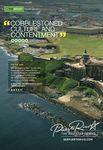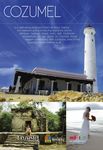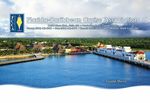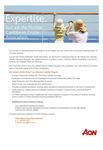Cruise Industry Overview 2015
←
→
Page content transcription
If your browser does not render page correctly, please read the page content below
Cruise Industry Overview - 2015
State of the Cruise Industry
2014
Another record was broken in 2014, with 22.1 million passengers cruising globally—a four percent increase
over 2013’s previous high of 21.3 million—and about 12 million sourced from North America. Coupled with an
annual occupancy percentage again exceeding 100 percent, this passenger growth shows sustained consumer
interest in cruising and an industry where demand continues to outstrip supply. Building onto the 18 percent
cruise ship capacity growth from 2009 to 2013, cruise lines released an additional 15 innovative, feature-rich
ships in 2014, but they also enhanced demand by establishing and increasing their presence in international
ports-of-call.
2015
This year is poised to reach new heights and break more records, with a forecast of 23 million sailing the oceans
on FCCA and/or CLIA Member Lines—a four percent increase over 2014. Driven by 22 new ships (6 ocean-going
vessels and 16 riverboats) representing 20,000 new beds and an investment of more than $4 billion slated for
2015, the record passengers will have the world as their gangway, with nearly 1,000 ports around the globe and
expansion in regions including the Mediterranean, Asia and Australia.
Despite this global growth, the Caribbean continues to headline the industry’s success. It again ranks as the
dominant cruise destination, accounting for more than a third (35.5 percent) of the global deployment capacity
market share.Region 2015 Deployed Capacity Share
Caribbean/Bahamas 35.5%
Mediterranean 19.5%
Europe w/o Med 10.6%
Asia 6.0%
Australia/New Zealand/S. Pac 6.0%
Alaska 4.5%
South America 2.9%
Other Programs 15.0%
Today’s ships offer a world of innovations that align with cruise lines’ brands—from sky-diving simulators
and robotic bartenders to celebrity chef kitchens and all-suite staterooms—and facilities that accommodate
family members of all generations traveling together or passengers cruising solo. Cruise ships’ facilities
and services continue to exceed the expectations of a growing population of travelers, and cruisers can
easily find a cruise brand, ship, stateroom and itinerary to suit them.
Note: Data provided by CLIA. Passenger statistics projected as of January 27, 2015; new vessels as identified through December 19, 2014; and
capacity deployment reflects that scheduled as of September 30, 2014. New ship announcements, vessel retirements and quarterly passenger
reporting will affect these figures.
Cruise Industry Overview
• In 2014, a record 22.1 million passengers are estimated to have cruised globally.
• The industry estimates 23 million to cruise globally in 2015.
• The cruise industry is the fastest-growing category in the leisure travel market. Since 1980, the
industry has experienced an average annual passenger growth rate of approximately 7.2% per annum.
• Since 1990, over 200 million passengers have cruised the CLIA North America brands. Of this
number, over 70% of the total passengers have been generated in the past 10 years and nearly 40%
in the past 5 years.
• The cruise product is diversified. Throughout its history, the industry has responded to vacation
desires of its guests and embraced innovation to develop new destinations, new ship designs, new
and diverse onboard amenities, facilities and services, plus wide-ranging shore side activities. Cruise
lines have also offered their guests new cruise themes and voyage lengths to meet the changing
vacation patterns of today’s travelers.
• The cruise industry’s establishment of over 30 North American embarkation ports provides consumers
with unprecedented convenience, cost savings and value by placing cruise ships within driving
distance of 75% of North American vacationers. By providing significant cost savings through the
convenience of avoiding air travel, the new homeports have introduced leisure cruising to a wider
customer base.• From a capacity standpoint, utilization is consistently over 100%.
• The Caribbean and Bahamas is the number one destination, with 35.5% of capacity in 2015.
• The current cruise ship order book from 2015-2020 includes 33 new ocean-going vessels from
FCCA/CLIA Member Lines, with over 100,000 berths and an investment value over $25 billion.
Note: Data provided by CLIA. Passenger statistics projected by CLIA as of January 27, 2015, and capacity deployment reflects that
scheduled as of September 30, 2014. New ship announcements, vessel retirements and quarterly passenger reporting will affect
these figures.
Economic Impact of Cruise Industry on Destinations
Highlights of the Business Research & Economic Advisors (BREA) 2012 study Economic Contribution of
Cruise Tourism to the Destination Economies* include:
• Cruise tourism contributed $1.99 billion of direct expenditures in the participating 21 destinations for
the 2011-2012 cruise year.
• Cruise ship calls brought 15.44 million passenger visits and 2.7 million crew to the participating
destinations during the 2011-2012 cruise year, which generated $1.48 billion and $261.9 million in
onshore spending, respectively.
• Average expenditure per passenger across all destinations was $95.92, and average expenditure per
crewmember was $96.98.
• Cruise-related expenditures generated 45,225 jobs throughout the studied destinations, which paid
$728.1 million in wage income to the residents.
• Based on these numbers, a single call from an average ship—130,000 GRT, 1,040 feet long, carrying
3,000 passengers and 500 crewmembers—generates $287,760 in passenger spending, $48,490 in
crew spending and roughly $15,000 in port fees, a total of $351,250 direct economic contribution, not
including wage labor and indirect contributions, such as goods and services used by tour operators,
shops, restaurants, etc.
• Cruise passengers were, in general, very satisfied with their Caribbean cruise vacation, with a mean score
of 7.6 for “overall visit” (using a 10-point scale with 10 being the highest and 1 being the lowest).
It is, therefore, clear that the cruise industry’s economic impact in the Caribbean and Latin American
regions is significant and continues to grow. The Member Lines of the FCCA urge you to carefully
analyze all this information and see for yourself how the cruise industry is positively impacting your
country’s economy.
Participants included: Antigua & Barbuda; Aruba; The Bahamas; Barbados; Belize; British Virgin Islands;
Cayman Islands; Colombia; Costa Rica; Curaçao; Dominica; Dominican Republic; Grenada; Honduras;
Nicaragua; Puerto Rico (San Juan); St. Kitts and Nevis; St. Maarten; St. Vincent and the Grenadines; Turks
and Caicos; U.S. Virgin Islands.
*This study is coordinated between the FCCA and BREA every three years, and participation is available for any interested
Caribbean/Latin American destination.Who Cruises and Why?
Findings from CLIA’s 2014 North American Cruise Market Profile
• Cruise travelers spread across the age spectrum, with one-quarter falling equally in the 30-39, 50-59
and 60-74 age groups.
• Cruisers’ annual household income was $114,000.
• The vast majority of cruise travelers were employed (72%), college educated (69%) and married
(84%).
• Past cruisers predominately believed that cruises should be taken often while mixing it up with land-
based vacations, with 34% responding this way. Another 18% strictly prefer cruise vacations over
other types and want to cruise as often as they can.
• The greatest benefit cruisers derived from their cruise vacation was the ability to see several
destinations in one trip, and 42% of cruisers later returned to a destination first visited during their
cruise vacation.
• When weighing cruise vacation options, cruisers placed cost and destination as top factors in their
selection, with entertainment and stateroom accommodations as important ship amenities.
• Past cruisers ranked the cruise vacation as the best overall vacation. The majority of cruisers (69%)
believed it to be a better value over land-based vacations; 89% of cruisers gave their cruise vacation
experience strong satisfaction ratings; and 84% would recommend cruising to friends.
• With a desire to cruise often, 62% of cruisers have taken multiple cruises, 3.8 on average. Yet new
cruisers accounted for 38% of cruise travelers.
• 86% of cruisers planned to take another cruise in the next three years.
• Cruisers spent an average of $2,200 per person on their last cruise, with $1,635 allocated to the fare,
$565 for onboard and shore expenses and $524 for airfare—among the 62% that flew to their port.What is the FCCA?
The Florida-Caribbean Cruise Association (FCCA) is a not-for-profit trade organization composed of 19
Member Lines operating more than 100 vessels in Floridian, Caribbean and Latin American waters. Created
in 1972, the FCCA’s mandate is to provide a forum for discussion on cruise operations, tourism development,
ports, tour operations, safety, security and other cruise industry issues. By fostering an understanding of
the cruise industry and its operating practices, the FCCA seeks to build cooperative relationships with its
partner destinations and to develop productive bilateral partnerships with every sector. The FCCA works
with governments, ports and all private/public sector representatives to maximize cruise passenger, cruise
line and cruise line employee spending, as well as enhance the destination experience and the amount of
cruise passengers returning as stay-over visitors.
Member Lines
AIDA Cruises, Azamara Club Cruises, Carnival Cruise Line, Celebrity Cruises, Costa Cruise Lines, Croisières
de France, Cunard Line, Disney Cruise Line, Holland America Line, MSC Cruises (USA) Inc., Norwegian
Cruise Line, Oceania Cruises, P&O Cruises, Princess Cruises, Pullmantur Cruises, Regent Seven Seas
Cruises, Royal Caribbean International, Seabourn, TUI Cruises
Partnerships
Some of the ways the FCCA works with the cruise-oriented destinations include:
• Port Improvements: The FCCA provides technical assistance on port expansion, including input on
port and pier design, improvements and planned new services.
• Research: Research is conducted and provided to destination partners in an effort to create a
better understanding of cruise passengers; improve the landside product delivery; and maximize
cruise tourism’s benefits.
• FCCA Outreach Program: FCCA training seminars provide destination partners with valuable
information regarding cruise passengers—their wants, needs and habits—enabling the destinations’
private and public sectors to optimize the impact of cruise tourists in their country. The FCCA has five
main training programs:
• Service Excellence: “Cruise Passengers Equal Profits:” Workshop on the importance of
excellent customer service and the economic impact of the cruise industry.
• Taxi Pride: Entertaining and informative workshop geared toward taxi drivers, tour operators
and vendors providing ground transportation. It focuses on five main areas: courtesy,
professionalism, marketing, rules and safety.
• FCCA/Aquila Shore Excellence Training: Two-hour workshop that enables tour operators and
destinations to discover tools that will assist in reaching new levels of performance,
productivity and profitability; build an action plan for exceeding the increasing expectations
of the cruise lines; learn how shore excursions work, how the cruise industry operates and
how to get your product in the hands of the right people; and minimize risk and emplace
effective risk management.• FCCA/Aquila Tour Guide Excellence Training Course: Online international certification program that
teaches participants what makes an excellent tour guide and the skills to turn that knowledge into a
practical reality when guiding cruise shore excursions. The program involves six interactive sessions
on cruise-specific topics, including: hospitality, service, research, presentation, preparation and risk
management.
• FCCA/Aquila Tour Operator Designation: Designation that signifies tour operators that meet the
requirements for service excellence in the cruise industry.
Additionally, the FCCA will design programs based on destination requests, including, but not limited to, spe-
cialized training; customized meetings; and site visits to inspect and discuss new or planned infrastructure
developments.
FCCA Membership
The FCCA has designed a two-tier membership program for destination partners and private organizations
impacted by cruise tourism to cultivate an even closer, direct working relationship with FCCA Member Lines.
Associate Membership
The FCCA Associate Membership Program is designed as a partnership to help promote a business to the cruise
industry at a great value. For only $500 per year (about $42 a month), it includes the following benefits:
• Exclusive Associate Member reception at the FCCA Cruise Conference and Trade Show
• Exclusive VIP tour during the FCCA Cruise Conference and Trade Show
• Upgraded FCCA membership badge at the FCCA Cruise Conference & Trade Show
• Savings on registration fees for the annual FCCA Cruise Conference & Trade Show
• $500 discount on advertising for first year of membership
• Discount on Tour Guide Excellence training and exclusivity on ACE Tour Operator Designation from
Aquila’s Center for Cruise Excellence
• Discount on insurance program for tour operators through AON Risk Services
• Discount on the FCCA Emergency Card Program through Trinity Air Ambulance
• Access to up‐to‐date research and statistical studies (customized to your destination if requested)
• Promotional updates on the cruise industry (current e‐mail required)
• Listing/profile in the FCCA Membership Directory
• Listing in the Conference issue of the FCCA’s quarterly magazine, Cruising Magazine
• Associate Member FCCA pin
• Membership certificate
• Use of Associate Member FCCA logo on printed materials and cruise line proposals
Platinum Associate Membership
Platinum Membership cultivates close relationships with FCCA Member Line CEOs, presidents and execu-
tives that decide what products are sold onboard and where ships call. For the price of some publications’
advertising, Platinum Members gain direct access to the cruise industry. In addition to the benefits above,
Platinum Membership includes:
• One complimentary cabin for the annual FCCA PAMAC Cruise Summit
• One complimentary cabin for inaugural cruise events• One complimentary hotel room for the annual PAMAC Conference
• One complimentary registration for the FCCA Gala
• One complimentary registration for the FCCA Cruise Conference and Trade Show
• Exclusive one‐on‐one meetings during the FCCA Cruise Conference and Trade Show
• Exclusive receptions during the FCCA Cruise Conference and Trade Show
• Private lunch meeting at the FCCA Cruise Conference and Trade Show
• Preferred VIP seating at the FCCA Cruise Conference Opening
• Exclusive VIP receptions at the FCCA booth during Cruise Shipping Miami
• Exclusive VIP events during Cruise Shipping Miami
• Access to FCCA Operations Committee meetings
• Chance to speak/present at FCCA panels, workshops and meetings
• Assistance setting meetings
• Company profile and updates in the FCCA’s quarterly magazine, Cruising
• Platinum listing in the FCCA’s Membership Directory
• Advertising and marketing discounts
• Membership in the FCCA Urgent Care Program through Trinity Air Ambulance
• Seat on FCCA’s Platinum Associate Membership Advisory Council (PAMAC)
• Platinum Membership plaque/clock
FCCA Events
The FCCA coordinates numerous events to promote mutual understanding and forge relationships between
the cruise lines and cruise tourism stakeholders. These range from close-knit, members-only events to the
larger, open-registration FCCA Cruise Conference & Trade Show, which gathers more than 1,000 attendees
with cruise line decision makers for a four-day agenda of meetings, workshops and networking opportunities.
The 2015 Conference will be held in Cozumel, Mexico from October 5-9.
FCCA Magazines and Publications
• Cruising – Published quarterly, Cruising is the official magazine of the FCCA and cruise
industry, serving to educate and enlighten about the industry’s inner-workings. With a distribution list
of over 18,000 via the Internet and direct mailings, Cruising offers advertisers access to over 13,000
travel agents, along with partner destinations’ private and public sectors and Member Line decision
makers in marine operations, marketing, strategic planning and more.
• Highlight Issue – Features a cruise industry who’s who, with cruise executive profiles and
information on FCCA Member Lines. Highlight Issue is an essential tool when dealing with the
cruise industry.
• Membership Directory – The FCCA Directory contains a complete listing of all FCCA Associate and
Platinum Members, as well as partner destinations’ ministers of tourism.
• Conference Program and Gala Program – Delegates attending these functions receive
comprehensive programs packed with useful FCCA schedules, information and accomplishments.FCCA Foundation
The FCCA Foundation provides a tangible mechanism for the cruise industry to fund a range of humanitarian
causes in Caribbean and Latin American destinations. In its 21 years, the Foundation has benefited thousands
of citizens by providing millions of dollars and countless hours to causes and charities throughout the regions.
In addition to assisting deserving institutions like charities and hospitals and aiding during crises like natural
disasters, the Foundation executes annual projects, including:
• Holiday Gift Project: The FCCA reaches out to many Caribbean and Latin American destinations by
providing gifts and holiday cheer to children in foster homes or institutions. The presents are
delivered to partner destinations on Member Lines’ vessels, and the crew and FCCA associates then
give the gifts at a festive party. In 2014, 33 destinations participated in the program, and about 7,000
children received presents and smiles because of the efforts.
• Children’s Essay and Poster Competitions: The FCCA orchestrates these competitions to further
educate FCCA destination partners’ youth by learning and thinking about the cruise industry’s impact,
along with their destinations’ and citizens’ roles in it, while also prompting practical problem solving.
There are two divisions—junior (12 years and under) and senior (13-16)—that each receive 1st-3rd-
place prizes of 3,000, 1,500 and 1,000, respectively, for themselves and their schools, along with a
$200 award for every finalist submitted by the participating destinations. The first place recipients
also receive functions in their honor.
Foundation Events (All Proceeds Support the Foundation)
• FCCA Online Auction: Taking place every December and open to anyone with a valid e-mail
address, this auction features items ranging from vacation packages, artwork, jewelry and sports
memorabilia—all graciously donated by FCCA Member Lines and partners throughout the Caribbean
and Latin America.
• FCCA Gala: Created by the Member Lines 21 years ago, the Gala gathers cruise executives and
industry stakeholders on a social level to establish new relationships or enhance existing ones. It
features a cocktail reception, silent art auction with works from Park West Gallery, and dinner with
a selected table host—each a Member Line executive, president and/or CEO. The 2015 Gala will take
place at the Miami Beach Convention Center during Cruise Shipping Miami on the evening of
March 18.
As the FCCA sails into the future, it remains steadfast in its mission to create mutually beneficial
relationships between cruise lines and partner destinations’ private and public sectors.Notes
You can also read





















































